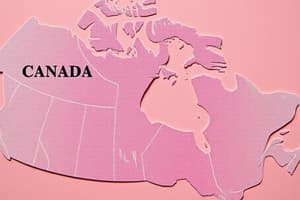Podcast
Questions and Answers
Which of the following best exemplifies how globalization impacts workforce dynamics in Canada?
Which of the following best exemplifies how globalization impacts workforce dynamics in Canada?
- An increase in the number of domestic manufacturing jobs due to protectionist trade policies.
- A decrease in reliance on technology within Canadian companies to prioritize local talent.
- A decline in cross-border trade resulting in greater self-sufficiency for the Canadian economy.
- A rise in outsourcing manufacturing jobs to countries with lower minimum wages. (correct)
How does the aging of the baby boom generation influence the Canadian workforce, according to the provided information?
How does the aging of the baby boom generation influence the Canadian workforce, according to the provided information?
- It results in a higher percentage of workers aged 55 years and over in the total employment. (correct)
- It leads to a younger average age of workers in the labour force.
- It causes a decline in women entering the workforce.
- It decreases overall workforce participation due to mandatory retirements.
Considering the trends in education and employment rates, what is a likely outcome for an individual in Canada without a certificate, diploma, or degree?
Considering the trends in education and employment rates, what is a likely outcome for an individual in Canada without a certificate, diploma, or degree?
- A higher likelihood of employment in administrative roles.
- A decreased employment rate compared to individuals with higher education levels. (correct)
- Greater opportunities in the technology sector due to industry demand.
- An employment rate comparable to those with university credentials.
Which of the following scenarios illustrates diversity in the Canadian workplace, as defined in the provided information?
Which of the following scenarios illustrates diversity in the Canadian workplace, as defined in the provided information?
What is the most likely company response to maximize efficiency during downsizing?
What is the most likely company response to maximize efficiency during downsizing?
Which action exemplifies ineffective communication leading to poor time management?
Which action exemplifies ineffective communication leading to poor time management?
How does inadequate planning most directly contribute to time mismanagement?
How does inadequate planning most directly contribute to time mismanagement?
What strategy is least effective for minimizing interruptions and maintaining focus on priority tasks?
What strategy is least effective for minimizing interruptions and maintaining focus on priority tasks?
Which scenario most effectively illustrates prioritizing tasks based on urgency and importance?
Which scenario most effectively illustrates prioritizing tasks based on urgency and importance?
What action is most effective for streamlining telephone communications to enhance time management?
What action is most effective for streamlining telephone communications to enhance time management?
How can employees best align their personal goals with organizational objectives to improve productivity?
How can employees best align their personal goals with organizational objectives to improve productivity?
What behavior exemplifies disorganization that leads to wasted time?
What behavior exemplifies disorganization that leads to wasted time?
How does using email as a substitute for personal contact impact efficiency?
How does using email as a substitute for personal contact impact efficiency?
Which action best showcases effective visitor management, balancing hospitality with productivity?
Which action best showcases effective visitor management, balancing hospitality with productivity?
Which scenario best demonstrates the application of strong interpersonal skills in a professional setting?
Which scenario best demonstrates the application of strong interpersonal skills in a professional setting?
A team leader notices a consistent decline in a team's output. Applying critical thinking, what should be their initial step?
A team leader notices a consistent decline in a team's output. Applying critical thinking, what should be their initial step?
An administrator is faced with multiple urgent tasks. Which action demonstrates effective time management?
An administrator is faced with multiple urgent tasks. Which action demonstrates effective time management?
Which of the following scenarios exemplifies a professional demonstrating a strong work ethic?
Which of the following scenarios exemplifies a professional demonstrating a strong work ethic?
An employee is asked to complete a task outside of their comfort zone. How would a self-confident professional most likely respond?
An employee is asked to complete a task outside of their comfort zone. How would a self-confident professional most likely respond?
What is the most effective strategy for using technology to manage information overload?
What is the most effective strategy for using technology to manage information overload?
Which of the following is the LEAST effective strategy for maintaining a healthy work/life balance?
Which of the following is the LEAST effective strategy for maintaining a healthy work/life balance?
In which scenario would gap analysis be MOST beneficial for a business?
In which scenario would gap analysis be MOST beneficial for a business?
A project manager is considering using gap analysis before starting an improvement project. What would be the MAIN benefit of doing so?
A project manager is considering using gap analysis before starting an improvement project. What would be the MAIN benefit of doing so?
Why is it important to tailor the gap analysis process to the specific situation and needs of an organization?
Why is it important to tailor the gap analysis process to the specific situation and needs of an organization?
Which of the following tools is LEAST likely to be directly used in conducting a gap analysis?
Which of the following tools is LEAST likely to be directly used in conducting a gap analysis?
What is the PRIMARY purpose of using performance indicators during a gap analysis?
What is the PRIMARY purpose of using performance indicators during a gap analysis?
If a company's customer satisfaction scores are consistently below the industry average, how might gap analysis be applied at the business level?
If a company's customer satisfaction scores are consistently below the industry average, how might gap analysis be applied at the business level?
In what way can gap analysis be MOST effectively used at the process level within an organization?
In what way can gap analysis be MOST effectively used at the process level within an organization?
How can gap analysis assist in the definition stage of a project?
How can gap analysis assist in the definition stage of a project?
After identifying a skills gap within a team, what is the MOST logical next step based on the principles of gap analysis?
After identifying a skills gap within a team, what is the MOST logical next step based on the principles of gap analysis?
Flashcards
Diversity in the Workforce
Diversity in the Workforce
The inclusion of various factors such as race, gender, age, and abilities in the workplace.
Baby Boom Generation
Baby Boom Generation
Individuals born between 1946 and 1964, known for a significant increase in birth rates.
Employment Rate by Education
Employment Rate by Education
The percentage of people employed based on their education level.
Globalization
Globalization
Signup and view all the flashcards
Telework
Telework
Signup and view all the flashcards
Communication Skills
Communication Skills
Signup and view all the flashcards
Information Management
Information Management
Signup and view all the flashcards
Critical Thinking
Critical Thinking
Signup and view all the flashcards
Time Management
Time Management
Signup and view all the flashcards
Interpersonal Skills
Interpersonal Skills
Signup and view all the flashcards
Professional Characteristics
Professional Characteristics
Signup and view all the flashcards
Identifying Time Wasters
Identifying Time Wasters
Signup and view all the flashcards
Ineffective Communication
Ineffective Communication
Signup and view all the flashcards
Poor Telephone Techniques
Poor Telephone Techniques
Signup and view all the flashcards
Inadequate Planning
Inadequate Planning
Signup and view all the flashcards
Interruptions
Interruptions
Signup and view all the flashcards
Disorganization
Disorganization
Signup and view all the flashcards
Procrastination
Procrastination
Signup and view all the flashcards
Establishing Priorities
Establishing Priorities
Signup and view all the flashcards
Email Management
Email Management
Signup and view all the flashcards
Setting Visitor Appointments
Setting Visitor Appointments
Signup and view all the flashcards
Gap Analysis
Gap Analysis
Signup and view all the flashcards
Current State
Current State
Signup and view all the flashcards
Future State
Future State
Signup and view all the flashcards
Action Plan
Action Plan
Signup and view all the flashcards
Performance Indicators
Performance Indicators
Signup and view all the flashcards
Business-Level Gap Analysis
Business-Level Gap Analysis
Signup and view all the flashcards
Process-Level Gap Analysis
Process-Level Gap Analysis
Signup and view all the flashcards
SWOT Analysis
SWOT Analysis
Signup and view all the flashcards
Steps to Conduct Gap Analysis
Steps to Conduct Gap Analysis
Signup and view all the flashcards
Study Notes
Diversity in the Workplace
- Diversity in Canada includes race, ethnicity, religion, culture, newcomer status, geography, language, politics, gender, beliefs, sexual orientation, economic status, abilities, skills, and interests.
- In 2011, workers aged 55+ comprised 18.7% of the total employment, compared to 15.5% in 2006.
- The increase is due to the aging of the baby boomer generation and more older workers participating in the labor force.
Women in the Workforce
- In 2011, women made up slightly less than half of the employed workforce (48.0%).
- In sales and service occupations, women comprised 27.1% of the workforce.
- Women made up 24.6% of the business, finance, and administration workforce, and 16.8% of the educational services, health care, and social assistance workforce.
Baby Boom Generation
- People born between 1946 and 1964 are considered baby boomers.
Education in the Workforce
- In 2011, the employment rate for people aged 25-64 was 75.3%.
- 30.8% of this group had university credentials.
- 12.7% had no certificate, diploma, or degree.
Globalization
- World economies are interdependent due to increased cross-border commodity/service trade and international capital flow.
Downsizing
- Companies increase efficiency by getting more done with fewer employees.
- They lay off non-essential employees.
Outsourcing
- Companies reduce costs by outsourcing manufacturing to countries with lower minimum wages.
Telework
- Work performed from various locations using telecommunications (e.g., call centers, cold-calling).
Remote Employment
- Work done mostly away from a traditional workplace.
Virtual Office
- Work done remotely using technology while appearing to be in a physical location (e.g., a virtual meeting).
Sole Proprietorship
- Business owned and controlled by one person who receives all profits and bears all debts.
- Examples include restaurants, shops, landscaping, and pet care.
Partnership
- Business owned by two or more people who share business decisions, profits, and debt.
- Examples include small law firms and medical practices.
Corporation
- Legal entity created by a formal process.
- Can be privately or publicly owned (e.g., Costco, Desjardins, Honda, McCain Foods, Royal Bank of Canada, Canadian National Railway, Suncor Energy).
Formal Organizational Structures
- Common structures include a board of directors, chief executive officer (CEO), chief information officer (CIO), vice presidents, managers, and employees.
Organizational Culture
- Reflects values, beliefs, and attitudes of an organization.
- Expressed through symbols like dress codes and unwritten rules.
- The atmosphere of a workplace influences employee and customer perceptions.
- Examples include formal business suits in legal offices and casual Fridays.
Role of the Administrative Professional
- Typical work involves 40 hours/week of office work, supporting others, responding to inquiries, managing office tasks, and being the initial point of contact for questions.
Employability Skills (Administrative Professionals)
- Strong communication skills (oral, written, and non-verbal).
- Ability to manage information.
- Proficiency with technologies.
- Ability to solve problems & manage time effectively
Time Management Tips
- Create a daily plan, set time limits, use organizers, know important deadlines.
- Block out distractions, track time, prioritize, delegate, limit time-wasters.
- Have a clock readily available.
Disorganization
- Messy workspaces, difficulty filing documents, and procrastination.
Establishing Priorities
- Prioritize tasks by urgency and importance (Important & Urgent, Important & Not Urgent, Urgent & Not Important, Not Urgent & Not Important).
Minimizing Interruptions
- Email: Determine email check intervals, respond directly, do not let it replace personal contact.
- Telephone: Record information clearly, identify yourself/supervisor, avoid non-urgent calls during working hours.
Visitors
- Set up appointments, discourage unexpected visitors unless necessary, politely guide visitors to appropriate individuals.
Organizational Goals
- Employee input in organizational planning helps reflect their understanding of organization goals.
Personal Goals
- Examples of personal goals are career goals, acquiring a house, or wanting a change of scenery.
Characteristics of Effective Goals (SMART Goals)
- Specific, Measurable, Achievable, Relevant, and Time-bound.
Well-Organized Workspace
- Promotes employee morale, professionalism, organization, health, and efficiency. - Cleaner workplaces show appreciation and careful planning to customers and colleagues.
Customer (External/Internal)
- Customers are those who purchase products/services from a business.
- Internal customers are employees within an organization who use products/services.
Customer Service
- Ability of an organization to provide consistent quality service, meeting customer needs.
- Ability of an organization to provide consistent quality service addressing customer needs.
Customer Focus
- Centrality of customer needs to an organization as it helps provide top quality service.
Customer/Visitor Focus Strategies
- Maintain focus, be respectful, listen to customer input, be responsible and explain situations to customers clearly.
Customer Service Skills
- Empathy, communication, listening, product knowledge, problem-solving, patience, positive attitude, positive language, personal responsibility, confidence.
- Authenticity, adaptability, attentiveness, desire to learn, professionalism, acting ability, time management skills.
Gap Analysis
- Used to assess the difference between current and desired skill levels in employees, or for an organization's business process.
- Identify skills needed to improve, create action plans to address the identified skills gap.
Communication
- Message: the idea being communicated
- Originator: the sender of the message
- Channel: the method of sending the message (e.g., email, in-person, letter)
- Receiver: the recipient of the message
Verbal Communication
- Includes pitch (high/low), tone (attitude), pace (speed), and volume (loudness)
- Important to project confidence and ensure listener understanding.
Nonverbal Communication
- Includes body language, gestures, and facial expressions.
Listening Types
- Casual: objective of relating to others (e.g., during lunch)
- Active: focuses on understanding speaker's meaning (e.g., during a discussion)
- Informative: to hear, understand, and remember information.
- Evaluative: to understand and judge information.
- Empathetic: to understand and provide feedback to the speaker.
- Reflective: to offer feedback that helps speaker focus on their feelings or objectives.
Written Communication
- Emails: short, one screen length, include subject lines, use appropriate tone. Ensure the purpose of the email is clearly identified.
- Memoranda: longer, typed messages, typically used internally, often for policy changes or internal communication.
- Letters: formal, more formal means of communication, for formal situations/external customers, includes company letterhead, and logo.
- Reports: for internal use or for submission, covers many different topics including sales, health and safety, and research projects.
- Consider the purpose of the correspondence and consider your audience when writing.
Proofreading
- Tone, audience, effective paragraphs, spelling/grammar, vocabulary, and punctuation.
- Use available tools and professional tips to improve quality of writing. Check consistency and accuracy.
- Correct dates, using thesaurus if needed.
Studying That Suits You
Use AI to generate personalized quizzes and flashcards to suit your learning preferences.




